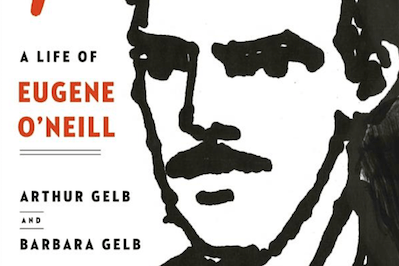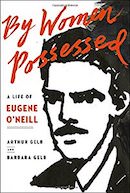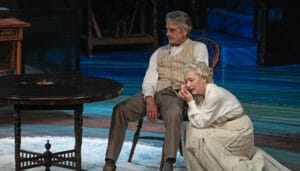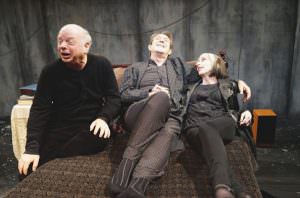‘By Women Possessed: A Life of Eugene O’Neill’
His creative career as one of America's greatest playwrights is unmatched. It is as difficult to put down this exhaustively reported re-examination of O'Neill's dark family backstory as it is to ignore fresh productions of his great plays.
Marian Wood Books / Putnam
|
To see long excerpts from “By Women Possessed” at Google Books, click here. |
“By Women Possessed: A Life of Eugene O’Neill”
A book by Arthur Gelb and Barbara Gelb
Playwright Eugene O’Neill has commanded a substantial portion of the life work of Arthur Gelb and Barbara Gelb. In 1962, the writing duo published the titanic biography “O’Neill,” a foundation they built upon with Barbara Gelb’s “My Gene” in 1986, their “O’Neill: Life With Monte Cristo” in 2000 and the documentary “Eugene O’Neill” in 2006. As the couple were working on their latest volume, “By Women Possessed: A Life of Eugene O’Neill,” in 2014, Arthur, a former managing editor of The New York Times, died, and Barbara completed the work on her own.
“By Women Possessed” is more than 750 pages of prose that admirably captures O’Neill’s tempestuous life. The book delivers new material: previously unavailable diaries of O’Neill’s widow Carlotta Monterey, unpublished parts of earlier interviews the Gelbs conducted and an assessment of “Exorcism,” O’Neill’s 1920 play discovered in 2011 that portrays his 1912 suicide attempt.
 By Women Possessed: A Life of Eugene O’Neill
Purchase in the Truthdig Bazaar
By Women Possessed: A Life of Eugene O’Neill
Purchase in the Truthdig Bazaar
The Gelbs return to O’Neill again to pursue the angle announced by the book’s title. In “By Women Possessed” we find O’Neill bedeviled by his morphine-riddled mother, Ella, and bedeviling his own wives and lovers as a maudlin and violent drunk. In this narrative of the years O’Neill was married to Agnes Boulton and then to Monterey, the Gelbs provide a steady, unflinching examination of the influence the women in his life had on his work.
The saga begins with the 1928 Broadway opening of “Strange Interlude,” O’Neill’s experimental five-hour drama that uses soliloquies to reveal the characters’ inner thoughts. At the time, O’Neill’s career was flourishing — he received his third Pulitzer Prize for “Strange Interlude” — yet his divorce from writer Boulton was imminent. (The Gelbs describe his first union, to Kathleen Jenkins, in 1909 when he was 20, as an “irresponsible forced marriage” due to Jenkins’ pregnancy.) O’Neill’s life with Boulton, five years his junior, was as overheated as the pulp genre fiction she was writing when they met. The Gelbs present a portrait of O’Neill as myopic, selective with facts, and intensely vengeful as his marriage crumbles because of his infidelity, hypocrisy and wild accusations against his wife. He was also often profoundly drunk and dangerous: O’Neill’s bouts with both Boulton and Monterey ranged from punches to a brandished gun.
O’Neill divorced Boulton in 1929 and within weeks married Monterey, who occupies a conspicuous place in the volume thanks to the new diaries, which the Gelbs call “revelatory and often stunning.”
We get a thorough depiction of O’Neill’s consuming, corrosive relationship with her, a death spiral described at one point as “Grand Guignol” but that began cheerfully enough. In their early years the couple doted on each other, scrawling pussycats on their mash notes. For insight into the relationship, the Gelbs examine O’Neill’s 1934 play “Days Without End,” a work that mixes notions of romance and eternity into an incoherent spiritual mess; it was a flop, prompting the Gelbs to surmise, “Perhaps, in one of his mind’s smoky tunnels, [O’Neill] blames the play’s ill-conceived concept on his hyperbolic adoration of Carlotta at that time.”
Toward the end of the marriage, when the relationship was deteriorating, O’Neill broke his leg in the front yard and lay in the snow as his wife gloated — or so the famous story goes. The incident is rehashed from all conceivable angles; so is a fraught dinner with friends, which gets seven full pages parsing their marital collapse.
The Gelbs interpret O’Neill’s plays through the traumas of his life, scrutinizing his mother’s role in the creation of Mary Tyrone in “Long Day’s Journey Into Night” and Deborah Harford in “More Stately Mansions.” Describing O’Neill’s portrayal of Harford, the authors write that it was “a vicious indictment by a son who could not forgive his mother for wishing him dead at birth.” In the character of Sara Melody, who wars with her father in “A Touch of the Poet,” the Gelbs see echoes of O’Neill’s daughter Oona, who infuriated her father by marrying Charlie Chaplin, who was nearly the same age as O’Neill. “It’s a fair guess that to some degree O’Neill’s consuming anger over Oona’s evident disregard for her father’s sensibility influenced his reshaping of Sara Melody’s character,” the Gelbs write.
Inevitably, the Gelbs recast old material and repurpose it — sometimes even reprint it. They revisit the question of whether Monterey rewrote O’Neill’s diaries after his death, a subject they pondered in the 1987 epilogue to “O’Neill.” “She would have to have been an extremely skillful forger to simulate O’Neill’s distinctive, crabbed penmanship,” they wrote then. In the epilogue of “By Women Possessed,” they write: “She would have to have been a master forger to simulate his distinctive crabbed penmanship.”
O’Neill’s unmatched creative career and his dark family backstory make for compelling reading. It is as difficult to put down this exhaustively reported re-examination of America’s first major playwright as it is to ignore fresh productions of his great plays.
Nelson Pressley is a theater critic for The Washington Post.
©2016, Washington Post Book World Service/Washington Post Writers Group
Independent journalism is under threat and overshadowed by heavily funded mainstream media.
You can help level the playing field. Become a member.
Your tax-deductible contribution keeps us digging beneath the headlines to give you thought-provoking, investigative reporting and analysis that unearths what's really happening- without compromise.
Give today to support our courageous, independent journalists.






You need to be a supporter to comment.
There are currently no responses to this article.
Be the first to respond.